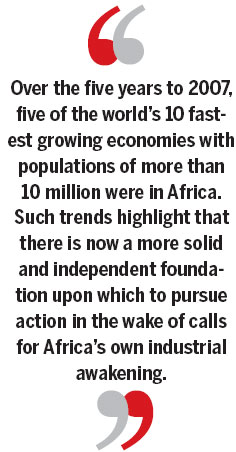


Industrialization should be the main growth driver for African policymakers
Exporting commodities for manufacturing has been one of the main reasons for Africa's long-standing default position of being a colonial trader, and the same seems to be holding true for the continent's largest trade partner, China. There is now a consensus that it is time for Africa to change tack and embark on the path of industrialization.
At this potentially momentous turning point, it is important to reflect on the ideas of the late American economist Alice Amsden. A champion of industrial policy, Amsden fully understood its uses and limits. Her research on East Asian industrialization, especially of South Korea and Taiwan, has often laid the groundwork for the economic upgrade that is taken for granted today. Similarly, while the World Bank is promoting "new structural economics" and its affiliation with industry policy, it is worth remembering that it was Amsden who talked about dynamic state intervention and its role in economic growth.
There is all the more reason to study Amsden and her works after reports suggested that both China and Africa are yet to make the most of their economic potential. Earlier this year Nigerian Central Bank Governor Lamido Sanusi wrote in an article in the Financial Times that it was time for African policymakers to be unromantic in how they face their biggest challenges, including in ties with China.
Sanusi said that China has become as much a threat as an opportunity in terms of Africa's own need to achieve productivity high enough to escape the default position of exchanging resources for manufactured goods.
Underlying Sanusi's fears is the striking divergence in the economic importance of manufacturing in East Asia and Africa over the last few decades. In East Asia the average share of manufacturing's share of GDP has risen, while since 1980 Sub-Saharan Africa has experienced de-industrialization. Even in the relatively industrialized South Africa, manufacturing comprises a mere 15 percent of GDP. The level elsewhere is even lower, about 11 percent in Kenya - another of Africa's more industrialized economies - and 10 percent in Nigeria. By comparison, around one-third of China's GDP is related to manufacturing.
Adding further impetus to the call for African economies to improve, especially in their exchanges with China, is Zimbabwean Minister of Finance Tendai Biti. Citing the example of Africa's struggling textiles industry in the face of competition from China, Biti insists that, "though Africa needs China it is important to create an equitable relationship".
Such concerns are not new. In 2007, former South African President Thabo Mbeki voiced concerns about a repeat of colonial economic patterns. "If Africa continues to just export raw materials to China while importing Chinese manufactured goods, the African continent could be condemned to underdevelopment."

However, since 1995 and especially in the past five years, on average there has been much higher growth and greater macroeconomic stability across the continent. Over the five years to 2007, five of the world's 10 fastest growing economies with populations of more than 10 million were in Africa. Such trends highlight that there is now a more solid and independent foundation upon which to pursue action in the wake of calls for Africa's own industrial awakening.
Many African leaders are also forthright in their view that China is a great opportunity for Africa. Among them is Cote d'Ivoire President Alassane Dramane Ouattara, who says that "China's development is a great opportunity rather than a threat to Africa".
Whether China is indeed a threat or opportunity, or both, the political consensus in Africa has been veering towards industrialization. In March at the sixth joint annual meeting of the African Union Conference of Ministers of Economy and Finance and the Economic Commission for Africa, in Ethiopia, Ouattara said that it is essential for Africa to take bold steps to industrialize and to accelerate economic growth.
In his speech at the 2013 World Economic Forum on Africa in Cape Town, the Bank of Tanzania Governor Benno Ndulu expressed optimism that "Africa would continue to focus on its advantages like low labor costs and youth. The geese of manufacturing are flying westwards from East Asia. They will land in Africa and stay there".
Ndulu was referring to the flying geese model. This explains the process of industrialization over time. An initial "goose", the more developed economy, leads the second tier "geese", the less developed economies, to new markets for nesting. In turn, these geese are followed by third-tier geese, and so on. In real life this arises as a process of gradual labor production outsourcing, across time and countries.
The reality is that a manufacturing boom will not happen by voicing political commitment alone. Worse, industrial policies of earlier eras in Africa have delivered mixed, often adverse, results. Now Sanusi says, "romance must be replaced by hard-nosed economic thinking".
In his speech, Zhong Jianhua, special representative of the Chinese government on African affairs, said that it was good that African countries are now thinking of competing with China.
"We have to figure out how to use the resources in Africa for its transformation", said Donald Kaberuka, President of the African Development Bank. Ndulu exuded further confidence by saying that the "flying geese" are now well on their way to settle in Africa.
It is here that Amsden once again comes into the picture. Amsden was one of the few who had studied how and why "geese" settle and where and how they do so over time. The findings represent proactive policy reference points of greater practical value.
Further, if China and its outbound geese do present "a great opportunity rather than a threat to Africa", then identifying practical contemporary African policy steps from the works of the likes of Amsden on East Asia's geese, that can feed directly into the Africa story itself, may be a useful way of realizing greater economic returns from China-Africa cooperation.
Underlying the sustainability and success of the learning process in Africa is discipline, which Amsden terms "reciprocal control mechanisms". This is what has helped to underpin the state-led development model in countries like China. To that end, the receipt of government support and industrial incentives was possible only if performance criteria were met.
At the heart of Amsden's seminal works Asia's Next Giant and The Rise of the Rest in particular was her effort to understand the systems through which East Asian governments were so able to discipline capital flows.
It is important if not obvious to emphasize the differences in the political systems of Africa and East Asia during industrialization. Beyond constitutional differences, modern communication technologies alone together with the prevalence of European languages on the continent make Africans vastly more connected to the outside world than East Asians in the second half of the 20th century. Similarly, the type of market intervention used by many East Asian states, including industry subsidies and trade controls, may be less available to leaders of African countries that are members of the World Trade Organization. Most of sub-Saharan African countries are WTO members. Whether these differences serve to be advantageous or otherwise, policies to stimulate a disciplined long-run transformation will need to be crafted accordingly.
It is obvious that China's home market dwarfs that of individual African countries. Sub-Saharan Africa collectively has 900 million people distributed across nearly 50 countries. China has a sovereign home market of 1.3 billion. As far back as 1776, Scottish economist Adam Smith observed: "The home market of China is, perhaps, in extent, not much inferior to the market of all the different countries of Europe put together". The same could be said of Africa. Scale matters in economics, and to industry policy especially.
As African political leaders declare that now is time for industrialization, it is important to learn from Amsden an outsider's assessment of the policies used in East Asia, and not even in any strict sense comparative static policy lessons. With the corpus of "lessons from East Asia" growing by the day, there may even be a risk that the latter could unintentionally form a new outside and increasingly homogenous script.
Amid mixed sentiment toward the balance of threat and opportunity presented by China in Africa, during his first speech in Africa the Chinese President Xi Jinping said China and Africa ties had reached the fast track of a path of "comprehensive development". Arriving with a more directed developmental focus of African leaders, this may or may not mean there is reason for Africa to forever roll out the red carpet for China. If that carpet leads with intention and economic disciplinary flexibility to a new higher-value added factory, with markets at home and abroad ready to be captured, then perhaps it forms a useful input to longer-term development goals.
The author, who holds a doctorate in Economics from Peking University, is a freelance writer in Beijing. The views do not necessarily reflect those of China Daily.
(China Daily Africa Weekly 07/12/2013 page11)
